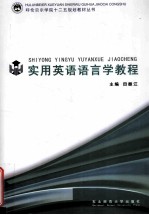

实用英语语言学教程PDF电子书下载
- 电子书积分:11 积分如何计算积分?
- 作 者:田振江主编;刘学明副主编
- 出 版 社:长春:东北师范大学出版社
- 出版年份:2012
- ISBN:9787560286433
- 页数:294 页
Part A Essentials of English Linguistics 1
A1 Language and linguistics 2
1.1 Language and its design features 2
1.2 Functions of language 2
1.3 Linguistic and important distinctions in it 3
A2 Phonetics and Phonology 4
2.1 Phonetics 4
2.2 The production of speech sounds 4
2.3 Transcription of sounds 12
2.4 Phonology 14
2.5 Suprasegmentals 17
2.6 Coariticulation 21
A3 Morphology 23
3.1 Word 23
3.2 Classification of words 24
3.3 Morpheme 27
3.4 Types of morphemes 29
3.5 Word-formation 31
3.6 Morpho-syntactical change 38
A4 Syntax 40
4.1 The Subject Matter of Syntax:Sentence 40
4.2 The Traditional Approach 43
4.3 The Structural Approach 49
4.4 The Generative Approach 52
A5 Semantics 62
5.1 Introduction 62
5.2 The Meaning of“Meaning” 62
5.3 Word meaning 65
5.4 Sentence meaning 79
A6 Pragmatics 87
6.1 What is pragmatics? 87
6.2 Speech Act Theory 90
6.3 Conversational Principle and Implicature 98
A7 Cognitive Linguistics 107
7.1 Language and Cognition 107
7.2 Cognitive linguistics 107
7.3 Approaches in Cognitive Linguistics 108
7.4 The Basic Concept:Categorization 109
7.5 Other Theories in Cognitive Linguistics 112
7.6 Other Issues in Cognitive Linguistcs 123
A8 Sociolinguistics 124
8.1 Sociolinguistics 124
8.2 Language variation 125
8.3 Language contact 128
8.4 Language plan and policy 130
A9 Theories and Schools of Modern Linguistics 133
9.1 Introduction 133
9.2 The Prague School 134
9.3 The London School 135
9.4 The American Structuralist School 137
9.5 The Transformational-Generative(TG)school 139
9.6 Later Theories 142
Part B Readers of English Linguistics 145
B1 Introduction 146
B1.1 Why Major in Linguistics? 146
B2 Phonetics and Phonology 151
B2.1 Phonetics 151
B2.2 Phonology 155
B2.3 Stess 158
B2.4 Intonation 167
B3 Morphology 175
B3.1 Why do languages have Morphology? 175
B3.2 Affixation 177
B3.3 Infixes 181
B3.4 Inflection vs.derivation revisited 182
B3.5 Lexical semantics 184
B3.6 Types of compounds 188
B3.7 Adopting and adapting words 191
B3.8 Lexical change 193
B4 Syntax 199
B4.1 Syntax 199
B4.2 Systemic-functional grammar 205
B5 Semantics 212
B5.1 Sense/reference/denotation/connotation 212
B5.2 Major sense relations 214
B5.3 Componential Analysis 220
B5.4 Sentence and proposition 225
B5.5 Process,participant and circumstance 227
B6 Pragmatics 233
B6.1 Speech acts 233
B6.2 The Cooperative Principle 238
B6.3 Relevance theory 245
B6.4 Politeness 246
B7 Cognitive Linguistics 254
B7.1 About cognitive linguistics:historical backgound 254
B7.2 The structure of cognitive categories 258
B7.3 From Wittgenstein to Rosch 260
B7.4 Metaphor and cognitive linguistics 263
B7.5 Conceptual metonymy 265
B7.6 Towards a theory of metonymy 266
B8 Sociolinguistics 269
B8.1 What is sociolinguistics? 269
B8.2 Class as a factor in linguistic variation 271
B8.3 Preferential gender differences 274
B8.4 Language and age 275
B8.5 Chinese Pidgin English 281
B9 Theories and Schools of Modern Linguistics 285
B9.1 Historicism 285
B9.2 Structuralism 286
B9.3 Functionalism 288
B9.4 Generativism 289
References 291
- 《高级英语阅读与听说教程》刘秀梅编著 2019
- 《思维导图 超好用英语单词书》(中国)王若琳 2019
- 《初中生英语作文 提高篇》清瑶主编 2019
- 《培生高级英语语法 练习册》培生教育 2019
- 《指向核心素养 北京十一学校名师教学设计 英语 七年级 上 配人教版》周志英总主编 2019
- 《365奇趣英语乐园 世界民间故事》爱思得图书国际企业 2018
- 《新课标背景下英语教学理论与教学活动研究》应丽君 2018
- 《幼儿英语游戏活动指导与实训》苏小菊,任晓琴主编;颜晓芳,覃静,谢恬恬,钟博维副主编 2020
- 《剑桥国际英语写作教程 段落写作》(美)吉尔·辛格尔顿(Jill Shingleton)编著 2019
- 《大学英语四级考试全真试题 标准模拟 四级》汪开虎主编 2012
- 《大学计算机实验指导及习题解答》曹成志,宋长龙 2019
- 《东北民歌文化研究及艺术探析》(中国)杨清波 2019
- 《大学生心理健康与人生发展》王琳责任编辑;(中国)肖宇 2019
- 《大学英语四级考试全真试题 标准模拟 四级》汪开虎主编 2012
- 《大学英语教学的跨文化交际视角研究与创新发展》许丽云,刘枫,尚利明著 2020
- 《中国地方艺文荟萃 华北东北卷 第1辑 3》《中国地方艺文荟萃》编委会编 2018
- 《中国地方艺文荟萃 华北东北卷 第1辑 1》《中国地方艺文荟萃》编委会编 2018
- 《复旦大学新闻学院教授学术丛书 新闻实务随想录》刘海贵 2019
- 《大学英语综合教程 1》王佃春,骆敏主编 2015
- 《唐代营州与东北边疆经略》宋卿著 2019
